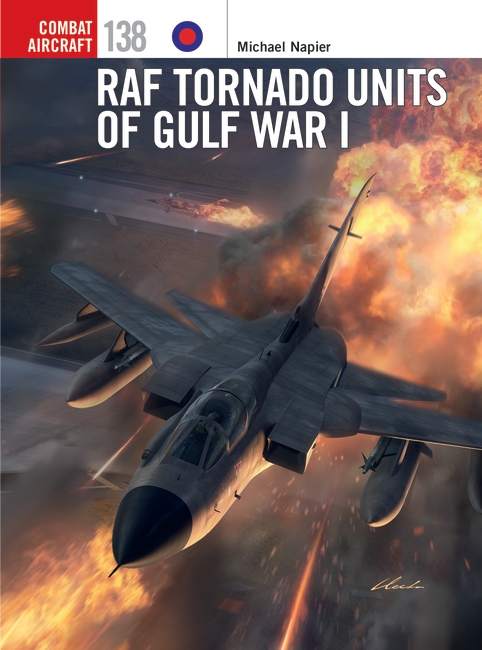The Panavia Tornado GR 1 and F 3 bore the brunt of RAF operational tasking (and combat losses) during the first Gulf War in 1991. On the blog today, Michael Napier, author of the upcoming Combat Aircraft title, RAF Tornado Units of Gulf War I, gives a brief overview of this aircraft's role in the Gulf War.
At the end of the Cold War in 1989, the Panavia Tornado, in its various marks, equipped 18 of the RAF front-line combat squadrons. Seven squadrons, all based in the UK, were equipped with the F3 Air Defence Variant, two with the GR1A reconnaissance variant and the remaining nine units with the GR1 Interdictor/Strike variant. Based at Brüggen and Laarbruch, eight of the GR1/1A squadrons made up the strike/attack force of RAF Germany. At the culmination of four decades of preparing for war against the Warsaw Pact in Europe, the RAF in general and the Tornado units in particular, were neither trained nor equipped to intervene in the Middle East. Indeed, to the personnel of the RAF Tornado force, the news of increasing tension between Iraq and Kuwait during the first half of 1990 was of little interest or relevance. However, when the Iraqi army invaded Kuwait on 2 August 1990, triggering a full international crisis, the Tornado crews and their ground crew soon found themselves involved.
The first response by the UK was to dispatch a squadron of Tornado F3 aircraft from Cyprus, where they were carrying out their annual Armament Practice Camp, to Saudi Arabia to help to protect the integrity of Saudi territory. Early on the morning of 11 August 1990, 12 fully armed Tornado F3s from 5 and 29 Sqns deployed in two waves to Dhahran. They were followed two weeks later by 18 Tornado GR1s which deployed to Bahrain, as the USA began to assemble an international Coalition to liberate Kuwait.
By the time the shooting war started on 16 January 1991, there were three Wings of Tornado GR1s based at Dhahran, Bahrain and Tabuk, as well as the Tornado F3 detachment at Dhahran. For the first five nights of the campaign, the Tornado GR1 Wings courageously flew low-level anti-airfield attacks, while the Tornado GR1As hunted for Scud missile launchers in the Iraqi desert and the Tornado F3 crews took part in defensive operations. A switch to night medium-level tactics by the Tornado GR1 force reduced the risks from ground-based anti-aircraft fire as well as surface-to-air missiles, but these improvements to the survivability of crews were bought at the cost of bombing accuracy. Another move to daylight operations on 25 January enabled more accurate visually aimed attacks, but it was the introduction of laser-guided weapons a week later that provided the key to successful bombing attacks. With these new weapons, the Tornados attacked bridges, airfields and other targets to great effect.
The Tornado GR1 crews showed incredible courage, flexibility and ingenuity as the campaign progressed and tactics had to be changed to meet the threat and the introduction of new weapons and delivery profiles. Similarly, the Tornado F3 crews found themselves learning to get the best from a plethora of modifications designed to improve the capability of their aircraft.
As an ex-Tornado pilot, I am uniquely qualified to write this detailed account of Tornado operations during the Gulf War. I was not involved in the conflict myself, so I am able to remain objective and non-partisan, but I am very familiar with the aircraft, its systems and tactics and I knew most of the participating aircrew well, so I can offer an expert insight into the events. Furthermore, many Tornado GR1 and F3 aircrew have entrusted me with their stories and memoirs, enabling me to weave those personal recollections into a detailed account of Tornado operations during the run-up to the Gulf war and throughout the War itself. The text is supported by images from the personal albums of Tornado crews and is supported by stunning artwork by Janusz Światłon illustrating the markings (including the unofficial nose art) of the aircraft involved in the conflict.
Preorder your copy of RAF Tornado Units of Gulf War I now!



Comments
You must be logged in to comment on this post. Click here to log in.
Submit your comment